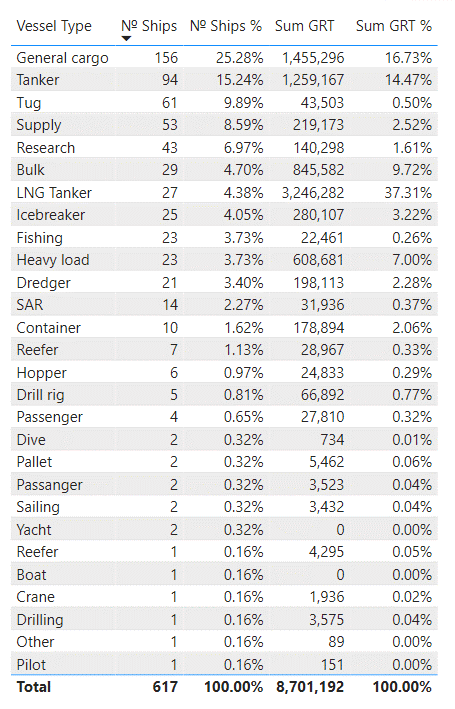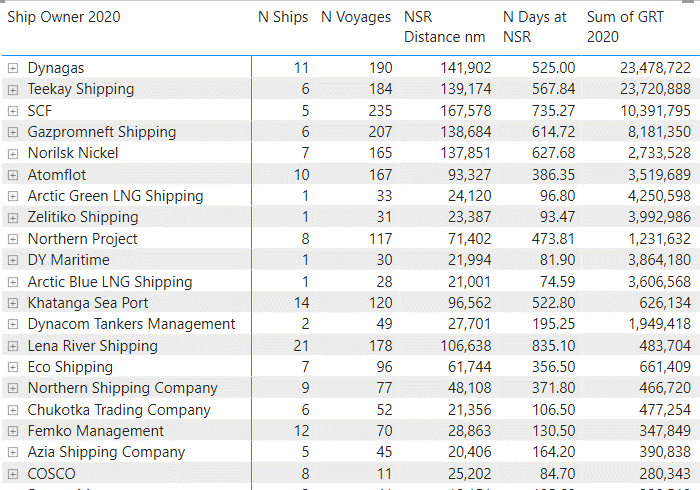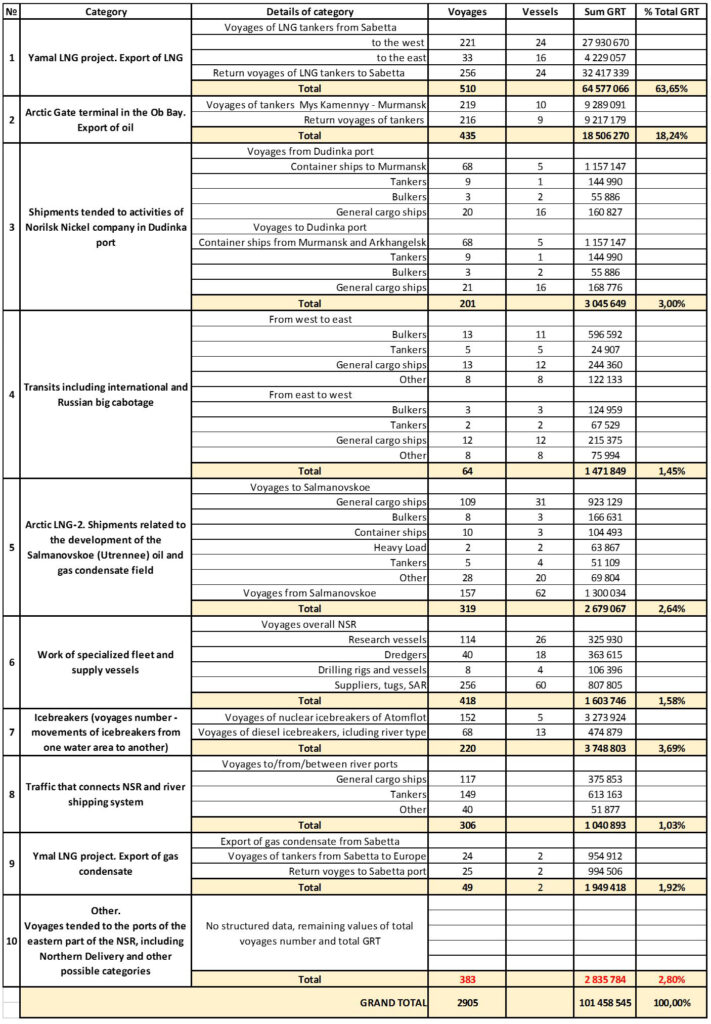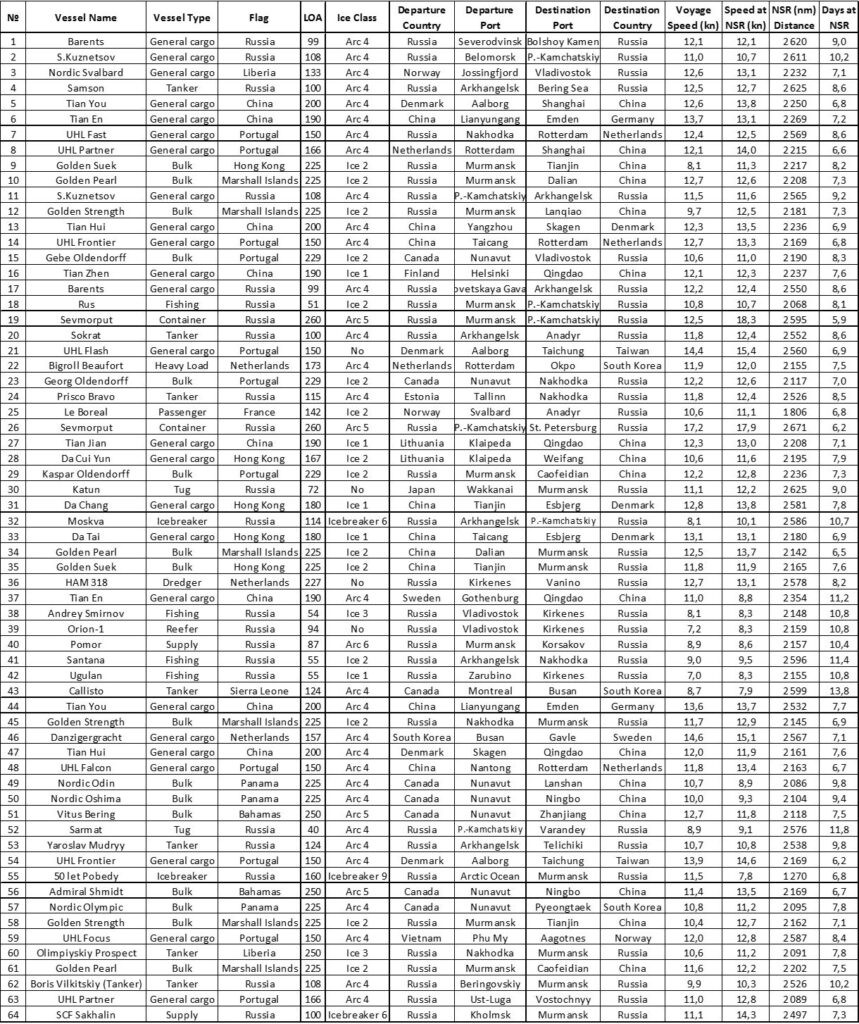Analysys of Shipping traffic in the NSR waters in 2020
The statistic report for 2020 is based on the AIS data and the information published on the Northern Sea Route Administration web-page. The report includes only those vessels that reflected in the information about movements of the vessels on the Northern sea route at the NSR Administration web-page. Work of various types of vessels is expressed via the number of performed voyages, the distance passed and GRT. This report also provides a brief analysis of transit traffic and considers the largest categories of transportations that form the main shipping traffic on the NSR in 2020. At first, for a general description of traffic on the NSR, we will give an overview of characteristics of the ships worked on the NSR over the past 5 years.
Vessels on the NSR in 2016-2020
In total, for the period from 2016 to 2020, 617 different vessels were recorded, the total GRT amounted to 8 701 192 registered tons.
241 shipowners, 27 different flags and 28 types of ships took part in the work on the NSR. With the quantitative distribution of ships by type, the largest number is the general cargo category – 156 ships or 25% of the total. The next type is tankers – 94 vessels or 15%. Next come tugs, supply vessels, research vessels and bulk carriers. LNG carriers rank 7th with 27 vessels and count over 4% of the total. The icebreaker fleet is at 8th position – 25 vessels, which also makes up about 4%. When dividing by flags in the categories of general cargo, tankers and tugs, ships under the Russian flag are in the first place, but supply ships are represented in the largest number by the Norwegian flag. As for gas carriers, here we see that there is not a single vessel under the Russian flag. The fleet of LNG carriers is of particular interest, since the total GRT of 27 LNG vessels is 3 146 282 register tons, which is more than 37% of the total tonnage of all vessels. Thus, the LNG tanker fleet ranks first in terms of GRT and is more than 2 times ahead of ships in the general cargo category. Out of 617 vessels, 174 have the most common ice class Arc 4, which is 28%. The ships without ice class – 107 or 17% are in second place in terms of number. Approximately the same number of vessels with ice class Ice 1. The number of vessels of the high ice class Arc 7 is 38 or 6% of the total. At the same time, the total GRT of these vessels reaches almost 30% of the entire fleet and is in first place. The vessels of Arc 4 ice class are in second place in terms of capacity, presenting 27% of the total volume. In terms of flags, 390 vessels out of 617 or 63 % of the total number operate under the flag of the Russian Federation. 31 ships (5%) are under the flag of the Netherlands and 20 ships (2%) are under the flags of Norway and Liberia. The total GRT of all 617 vessels is 8.7 million tons. Thus, the conventional average ship on the NSR has a size of about 14 100 register tons. An approximate length of such vessel can be about 160 m and width is 27 m. If we divide the fleet into different GRT segments, we will see that the largest number of vessels – 199 or 32% of the total number – is in the range from 1 000 to 5 000 GRT. The second and third places in terms of the number of vessels in the category are taken by vessels from 0 to 1 000 and from 5 000 to 10 000 GRT, each one with 106 vessels. Thus, 312 vessels or half of the total number are in the range from 0 to 10 000 GRT and form 15% of the total GRT. The largest vessels in the category from 100 000 to 130 000 GRT have 27 ships which form 37% of the total GRT. These are all LNG carriers. During the period 2016-2020, 241 shipowners participated in the work on the NSR. The number of vessels is dominated by Russian shipowners such as “Lena River Shipping”, “Marine Arctic Geological Expedition (MAGE)”, “Rosmorport”, “Khatanga Sea port”, “Northern Shipping Company” and others. If we consider the total GRT of ships in the context of companies, then 3 leading positions are occupied by: Dynagas with 11 LNG carriers of various ice classes, Teekay Shipping – 7 LNG carriers and COSCO – 12 general cargo ships and 6 heavy-lift ships. The 4th place is taken by Sovcomflot.
Work of vessels on the NSR in 2020
In 2020, 340 ships worked on the NSR, and made 2 905 voyages. In the concept of voyage, we mean the movement of a vessel from one port or water area to another port or water area.
49 tankers made the largest number of voyages – 750. The most voyages in this category – 435 – including ballast passages, fall into the category of export of oil products from the offshore terminal “Arctic Gate” at Mys Kamennyy. In general, 7 tankers of Arc 7 ice class worked for these transportations – 409 voyages including ballast. The category of general cargo vessels is in second place in terms of the number of completed voyages – 89 vessels and 710 voyages. There are LNG carriers in third place – 510 voyages: all the voyages are for the export of LNG from the port of Sabetta, including return voyages. A total of 254 voyages with LNG departed from Sabetta, carried out by 24 different vessels in 38 directions.
Another parameter which can describe the work of ships on the NSR is the total distance passed and the time spent by a vessel in the water area of the NSR. To assess these characteristics, we will consider not specific ships, but shipowners in order to evaluate their contribution to the activities on the NSR.
According to the parameter of the total distance, Sovcomflot is the leader – 5 ships of which made 235 voyages, the total distance was 167 678 nautical miles. The main contribution to the transportation was made by tankers Mikhail Lazarev, Shturman Ovtsyn, Shturman Albanov and Shturman Malygin that worked on the direction Mys Kamennyy – Murmansk. Dynagas company is in second place, her 11 LNG tankers passed 141 578 nautical miles during 190 voyages. In terms of time spent in the water area of the NSR, the leader is Lena River Shipping Company, whose vessels spent a total of 835 days on the NSR. Sovcomflot is in second place – 735 days and Norilsk Nickel is in third place – 627 days. We took into account only the time spent by ships during voyages, i.e. when the vessel moves from one place to another. The time of cargo operations and the time of stops between voyages were not included.
In addition to the total time and the total distance passed along the NSR, another important element which can quantitatively characterize the transportation in the water area of the NSR is the total GRT of vessels. This parameter shows the sum of the GRT of all voyages performed. Among the companies – Teekay Shipping and Dynagas make the largest contribution to the total GRT, they operate 17 LNG carriers of different ice class. They are followed by the companies Sovcomflot and Gazpromneft Shipping, mainly with tankers involved in the export of oil from the Arctic Gate Terminal near Mys Kamennyy.
When considering the parameter of the total GRT by vessel types, LNG tankers are expected to be in first place. In 2020, 24 LNG tankers made 510 voyages, their total GRT is more than 63% of the total GRT of all voyages in 2020. Second place is occupied by 49 tankers, which made 750 voyages, which is 21% of the total GRT, general cargo vessels are in 3rd place – 89 vessels, with 710 voyages, the contribution to the total GRT was 5%. The total GRT is distributed by flags as follows. 236 vessels under the flag of the Russian Federation are in first place, in 2020 they made 2 103 voyages out of 2 905, which is 72% of the total number of voyages or 31% of the total GRT. As for the ice class of vessel, first place in terms of the total GRT in 2020 is occupied by the vessels of the ice class Arc 7, 33 vessels made 1 100 voyages, which amounted to 81% of the total GRT. 89 vessels of ice class Arc 4, which made 486 voyages, are in second place with 8% of the total GRT.
Transit voyages
Transit navigation on the NSR became more active in 2010. In total, over 11 years, we have recorded 378 transit voyages. This includes international transit (203 voyages) and transit traffic between Russian ports (175). Among all the transit traffic, 213 voyages were directed to the east and 165 to the west. 54 of the 203 international transits were made by vessels under the Russian flag. In second place with 38 transits are ships under the flag of China. Norwegian vessels are in third place- 21 voyages.
In 2020, transit traffic began on July 20 (entering the NSR waters) and ended on November 17 (leaving the NSR after the last transit voyage). During these incomplete 4 months, 64 voyages were made, the total volume of transported cargo amounted to 1 281 010 tons. The main share of transported cargo belonged to iron ore concentrate (1 004 134 tons). There were 13 voyages with iron ore (6 from Murmansk and 7 from Nunavut, Canada) in 2020. Among the ships that took part in these transportations, 3 went also in the opposite direction from east to west (return voyages). The ice class of most of these vessels is low, 6 ships have Ice 2, 3 ships have Arc 4 and 2 ships have Arc 5. The GRT of only 2 ships exceeded 65 thousand tons. The rest are from 41 to 44 thousand tons. As for the rest of transit transportations: general cargo ships belonging to COSCO most of the other companies used routes of the NSR. A total of 8 vessels, with GRT from 22 to 26 thousand tons, made 11 voyages, from east to west and in the opposite direction. It should be noted that the return voyages were also loaded with cargo. In total, COSCO transported 198 451 tons. These were windmill equipment, wood pulp, fertilizer and other general and bulk cargo. The ports of exit and destination in Europe were in Denmark, Finland, Lithuania, Germany and Sweden.
The fastest of all the NSR crossed was a nuclear container ship “Sevmorput” – 5.9 days, the slowest was the ship “Callisto” – 13.8 days. Excluding these maximum and minimum values, we find out that, on average, in 2020, vessels that were in transit crossed the NSR in 8 days. At the same time, only one vessel used the icebreaker support (“Nordic Svalbard” vessel, the dates of the NSR passage late July – early August).
Structure of shipping traffic on the NSR in 2020
For an accurate, systematic description of the structure of shipping traffic on the NSR, it is necessary not only to record the voyages, but also to understand the intended purpose of a particular voyage. In 2020, we registered 583 different directions of voyages related to the NSR. Taking into account the wide variety of traffic in the summer-autumn navigation period, this task seems to be quite extensive and difficult. Nevertheless, the main part of vessel traffic in the water area of the NSR can be structured according to various parameters. As the main parameter for voyages in the traffic structure, we use projects carried out in the water area of the NSR. A secondary parameter can be a certain type of activity or, for example, connection with transportation routes. It is possible to structure most accurately and show quantitatively year-round transportation, which is carried out continuously, including the winter-spring navigation period. Year-round shipping traffic includes the export of LNG and gas condensate from the port of Sabetta, the export of oil from the offshore terminal “Arctic Gate” at Mys Kamennyy, the export of products of Norilsk Nickel company (white matte, sulfur and copper cathodes) and delivery of supplies to the port of Dudinka, delivery of materials and equipment for the development of the Arctic LNG-2 project to the Salmanovskoe (Utrennee) field and the operation of the icebreaker fleet.
The navigation significantly expands in the summer-autumn season due to the delivery of supplies to remote areas of the Far North, due to shipping traffic connecting the ports of the NSR and the river system adjacent to the NSR. Also research and drilling, dredging, international transit traffic, tourism and other activities are intensified in the summer-autumn season.
We have chosen GRT and number of voyages as the main parameters for describing the structure of the NSR shipping traffic. We have allocated 2 522 out of 2 905 voyages into 9 main traffic categories with a sufficient degree of reliability. According to the GRT parameter, this is 97.2% of the total GRT volume. The share of the remaining unallocated 383 voyages is 2.8% of GRT. All these remained voyages are included in the 10th category, it is difficult to determine and structure their purpose at the moment. Presumably, it includes voyages to the ports of the eastern part of the NSR. This issue will be studied further. Data on the proposed traffic structure is presented in table.
The largest category is the export of LNG from the port of Sabetta. 221 voyages were made in the western direction and 33 in the eastern one. In total, there are 510 voyages of LNG carriers including return ballast voyages, their total GRT amounts 63.65% of all transportations along the NSR in 2020. The earliest voyage in the eastern direction was on May 18th (ship “Christophe de Margerie”), and the latest was on December 6th (ship “Nikolay Zubov”), both voyages had icebreaker support. In 2020 Europe remains the main destination for the supply of gas products from Yamal. The main LNG consignees were Belgium, France, Spain, the Netherlands and China.
The next big category of the traffic is the export of crude oil from “Arctic Gate” terminal at Mys Kamennyy in the Ob Bay. There were 219 voyages of tankers of various ice classes and dimensions to the port of Murmansk in 2020. The major part – 205 voyages – was done with 7 tankers of Arc 7 ice class built specially for this project. 14 more voyages were made with the vessels of ice class Arc 5 and Arc 4. In total there are 435 voyages including ballast in this category of the traffic, its total GRT is 18.24% of the overall volume.
The third category includes the shipments tended to the activity of Norilsk Nickel company in Dudinka port. 68 voyages were made to Murmansk with 5 specific container ships of Arc 7 ice class. The same number was made in the opposite direction from Murmansk and Arkhangelsk to Dudinka. In addition to container shipments, tankers, bulk carriers and general cargo vessels operated in the port of Dudinka. The total number of voyages in this category is 201, their GRT is 3 045 649 t or 3% of the total GRT.
The 4th category includes international transits and transit voyages between eastern and western Russian ports. The total number is 64, its GRT amounts 1 471 849 or 1.45% of the total GRT.
We included transportation presumably related to the development of the Salmanovskoe (Utrennee) oil and gas condensate field (the Arctic LNG-2 project) in the 5th separate category. There are 319 voyages, 2 679 067 GRT or 2.64% of the total GRT. There are mainly general cargo voyages.
The work of specialized fleet and supply vessels on the NSR compiles the 6th category. The shipping traffic of the Northern Sea Route consists of not only transport activities but specialized works. Such works are research, drilling, dredging and work of supply vessels, tugs and SAR that provide the safe activities of the above three types. Active research work started with the beginning of the summer-autumn navigation period on the NSR. In total, in 2020, 27 vessels and 13 companies were involved in research work. The geography of work covered all the seas of the Northern Sea Route and most of the Arctic. The nature of the work performed by the research vessels is varied. For example, obtaining additional data on the seabed relief and the distribution of bottom sediments; assessment of the state of the marine environment and other tasks. As for the drilling works, 3 drilling rigs and 1 drilling vessel were involved in their implementation. “Bavenit” vessel carried out a complex of research works in the northeastern part of the Kara Sea near the Severnaya Zemlya archipelago. The Chinese drilling rig Nan Hai Jiu Hao (Nan Hai 9), owned by China Oilfield Services Limited (COSL), has drilled a new well Vikulovskaya-1 at the Vostochno-Prinovozemelskiy-1 area (owned by Rosneft). The second rig is Nanhai Bao Hao (Nan Hai 8), also owned by COSL, was involved to drill exploratory well No. 5 at the Leningradskoye gas condensate field for Gazprom Nedra LLC. The third rig, Oriental Discovery (owned by Tianjin CSSC) drilled the Ragozinskaya-1 exploration well at the Vostochno-Prinovozemelsky-2 area for Rosneft. A lot of work has been done in the dredging area. A total of 18 dredging vessels were involved. The main geography of the work was in the Ob Bay, there were reconstruction of the “Sea Canal” facility (a navigation approach channel in the Ob Bay of the Kara Sea). The dredging and auxiliary fleet was mobilized from various ports in Europe and Russia – Antwerpen, Bremerhaven, Amsterdam, Rotterdam, Murmansk and Arkhangelsk. All vessels left the Ob Bay before the beginning of ice formation. For the stable operation of research, dredging and drilling vessels, a large number of suppliers, tugs, as well as SAR vessels were involved – a total of 60 vessels that performed 256 voyages. The bulk of the work was in the Kara Sea. The total GRT of this category is 1 603 746 or 1.58% of the total.
The 7th category is the icebreaker fleet. In 2020, 18 icebreakers were engaged to ensure safe navigation in the water area of the Northern Sea Route. All operating icebreakers can be conditionally divided into 3 categories: nuclear icebreakers – in 2020 the new icebreaker “Akrtika” joined this group and now there are 5 such icebreakers in total; diesel icebreakers, there are 10 of them, and 3 river icebreakers operating at river mouths, adjacent to the sea routes and on their approaches, between the Siberian rivers, as well as in bays and coastal areas of the eastern part of the NSR. When calculating the activity of icebreakers, for 1 voyage we take the movement of the icebreaker from / to the port or area of work, as well as the passage from one area of work to another. In total, there were 220 such passages in 2020. The river icebreakers have low ice class – Ice 1 and Arc 4 – that is why their work takes place only in summer navigation period. Another cause is that navigation between the Siberian rivers stops in winter. The bulk of the work falls on nuclear and diesel icebreakers. More than half – 152 voyages – is accounted for nuclear icebreakers. In 2020 mainly nuclear icebreakers operated in the winter period, there were only 16 passages in the summer, while there were 136 in winter. In summer, nuclear icebreakers practically did not participate in supporting navigation in the Kara Sea on the approaches to the Ob Bay, the main work was on the routes of the NSR, in the eastern seas. A completely opposite picture can be seen in the work of the diesel icebreaker fleet. Most of the work was done in the Kara Sea – on the approaches to the Ob Bay from Cape Zhelaniya and the Kara Gate in summer navigation period. In winter, diesel icebreakers operated mainly at the ports of Sabetta, Dudinka, as well as at the Arctic Gate terminal, near Mys Kamennyy. Overall contribution of this category to the total GRT is 3 748 803 or 3.69%.
The next 8th category is the traffic that links the NSR and river shipping system. Siberian rivers, adjacent to the Northern Sea Route, play an important role in summer-autumn traffic. In terms of the voyages number, river-sea transportations accounts for about 10% of all traffic in 2020. Traditionally, such transportations start in July and finish in October, that is connected with the ice class of ships mainly working in these directions. Ice class Ice 1 accounts for more than half of the traffic – 175 voyages, No Ice Class – 45, Ice 2 – 44. The total number of passages from and to Siberian rivers via the NSR is 306. Their total GRT is 1 040 893 or 1.03%. The main cargoes on this direction are oil products and general cargo. The highest activity in 2020 was observed in the ports of the Lena River (65 departures and 64 arrivals), Kolyma (59 departures and 60 arrivals) and Yana (45 departures and arrivals each). Less frequent shipping activity was in and out of the Ob, Khatanga, Anabar, Olenek, Indigirka, Yenisey rivers.
The 9 category is the export of gas condensate from the port of Sabetta as part of the project Yamal LNG. This is one more important element of the structure of the NSR shipping traffic. 2 tankers of ice class Arc 7 that have been constructed particularly for transporting of gas condensate – Boris Sokolov and Yurii Kuchiev – made 24 voyages to European ports. In total, including return voyages, this category amounts 49 voyages and 1 949 418 GRT, that is 1.92% of the total GRT.
The remaining 383 voyages and 2 835 784 GRT – 2.8% of the total volume, we included in the category “Other”. The purpose these voyages will be studied additionally.
The above information is not official statistics. The data was collected from various open sources, including AIS data and the website of the NSR Administration, and structured in order to quantify the shipping traffic in the water area of the Northern Sea Route.
photo: gazprom.com






